FIAT DOBLO COMBI 2016 2.G Owners Manual
Manufacturer: FIAT, Model Year: 2016, Model line: DOBLO COMBI, Model: FIAT DOBLO COMBI 2016 2.GPages: 298, PDF Size: 25.92 MB
Page 251 of 298
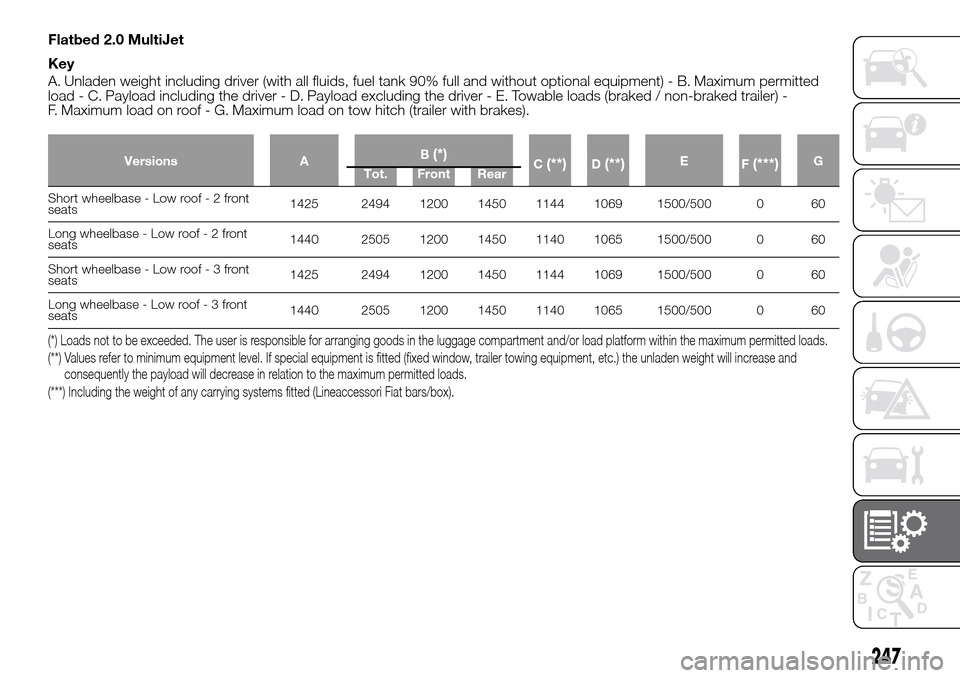
Flatbed 2.0 MultiJet
Key
A. Unladen weight including driver (with all fluids, fuel tank 90% full and without optional equipment) - B. Maximum permitted
load - C. Payload including the driver - D. Payload excluding the driver - E. Towable loads (braked / non-braked trailer) -
F. Maximum load on roof - G. Maximum load on tow hitch (trailer with brakes).
Versions AB(*)C(**)D(**)E
F(***)G
Tot. Front Rear
Short wheelbase - Low roof-2front
seats1425 2494 1200 1450 1144 1069 1500/500 0 60
Long wheelbase - Low roof-2front
seats1440 2505 1200 1450 1140 1065 1500/500 0 60
Short wheelbase - Low roof-3front
seats1425 2494 1200 1450 1144 1069 1500/500 0 60
Long wheelbase - Low roof-3front
seats1440 2505 1200 1450 1140 1065 1500/500 0 60
(*) Loads not to be exceeded. The user is responsible for arranging goods in the luggage compartment and/or load platform within the maximum permittedloads.
(**) Values refer to minimum equipment level. If special equipment is fitted (fixed window, trailer towing equipment, etc.) the unladen weight will increase and
consequently the payload will decrease in relation to the maximum permitted loads.
(***) Including the weight of any carrying systems fitted (Lineaccessori Fiat bars/box).
247
Page 252 of 298
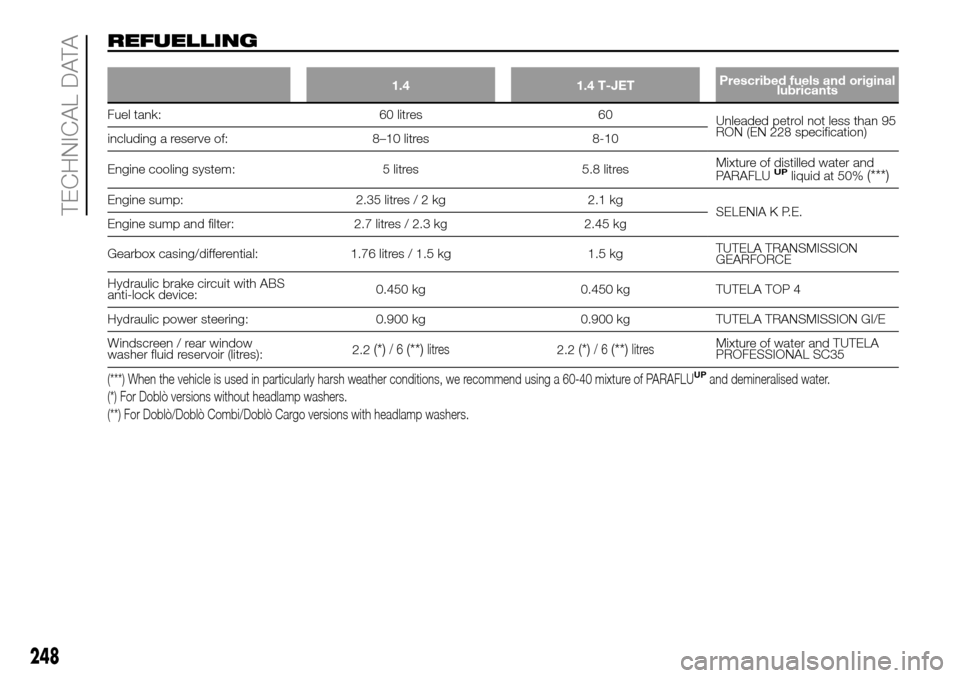
REFUELLING
1.4 1.4 T-JETPrescribed fuels and original
lubricants
Fuel tank: 60 litres 60
Unleaded petrol not less than 95
RON (EN 228 specification)
including a reserve of: 8–10 litres 8-10
Engine cooling system: 5 litres 5.8 litresMixture of distilled water and
PARAFLU
UPliquid at 50%(***)
Engine sump: 2.35 litres/2kg 2.1kg
SELENIA K P.E.
Engine sump and filter: 2.7 litres / 2.3 kg 2.45 kg
Gearbox casing/differential: 1.76 litres / 1.5 kg 1.5 kgTUTELA TRANSMISSION
GEARFORCE
Hydraulic brake circuit with ABS
anti-lock device:0.450 kg 0.450 kg TUTELA TOP 4
Hydraulic power steering: 0.900 kg 0.900 kg TUTELA TRANSMISSION GI/E
Windscreen / rear window
washer fluid reservoir (litres):2.2
(*)/6(**)litres2.2(*)/6(**)litresMixture of water and TUTELA
PROFESSIONAL SC35
(***) When the vehicle is used in particularly harsh weather conditions, we recommend using a 60-40 mixture of PARAFLUUPand demineralised water.
(*) For Doblò versions without headlamp washers.
(**) For Doblò/Doblò Combi/Doblò Cargo versions with headlamp washers.
248
TECHNICAL DATA
Page 253 of 298
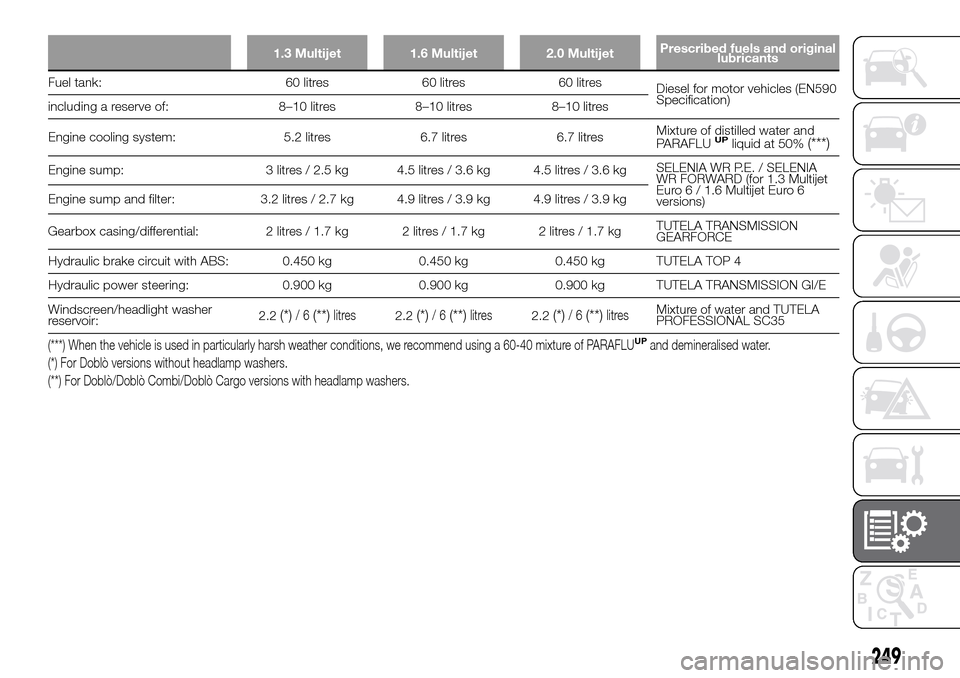
1.3 Multijet 1.6 Multijet 2.0 MultijetPrescribed fuels and original
lubricants
Fuel tank: 60 litres 60 litres 60 litres
Diesel for motor vehicles (EN590
Specification)
including a reserve of: 8–10 litres 8–10 litres 8–10 litres
Engine cooling system: 5.2 litres 6.7 litres 6.7 litresMixture of distilled water and
PARAFLU
UPliquid at 50%(***)
Engine sump: 3 litres / 2.5 kg 4.5 litres / 3.6 kg 4.5 litres / 3.6 kgSELENIA WR P.E. / SELENIA
WR FORWARD (for 1.3 Multijet
Euro 6 / 1.6 Multijet Euro 6
versions) Engine sump and filter: 3.2 litres / 2.7 kg 4.9 litres / 3.9 kg 4.9 litres / 3.9 kg
Gearbox casing/differential: 2 litres / 1.7 kg 2 litres / 1.7 kg 2 litres / 1.7 kgTUTELA TRANSMISSION
GEARFORCE
Hydraulic brake circuit with ABS: 0.450 kg 0.450 kg 0.450 kg TUTELA TOP 4
Hydraulic power steering: 0.900 kg 0.900 kg 0.900 kg TUTELA TRANSMISSION GI/E
Windscreen/headlight washer
reservoir:2.2
(*)/6(**)litres2.2(*)/6(**)litres2.2(*)/6(**)litresMixture of water and TUTELA
PROFESSIONAL SC35
(***) When the vehicle is used in particularly harsh weather conditions, we recommend using a 60-40 mixture of PARAFLUUPand demineralised water.
(*) For Doblò versions without headlamp washers.
(**) For Doblò/Doblò Combi/Doblò Cargo versions with headlamp washers.
249
Page 254 of 298
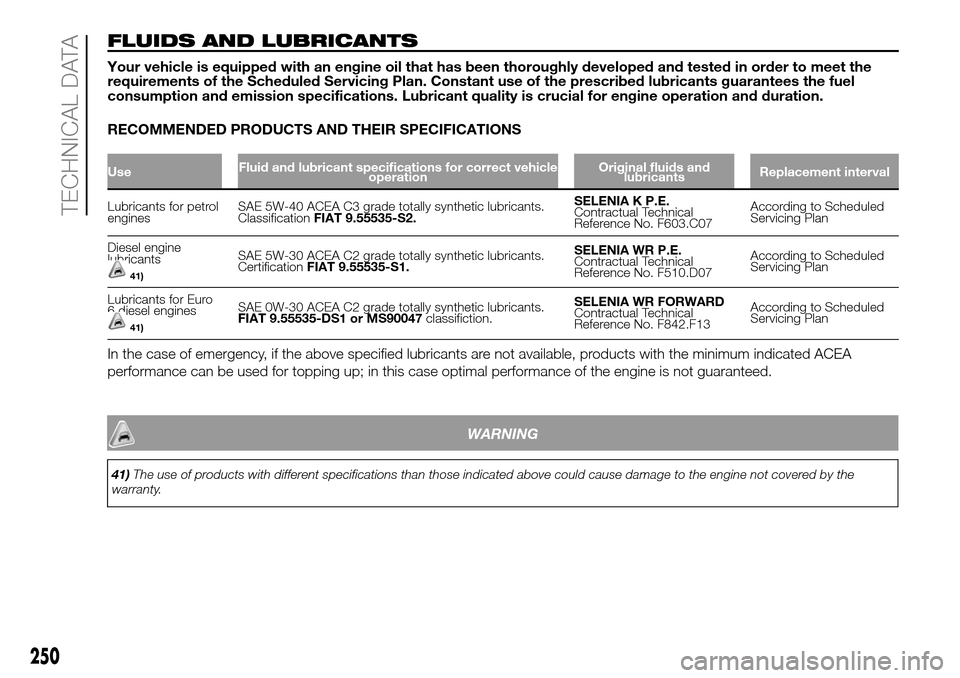
FLUIDS AND LUBRICANTS
Your vehicle is equipped with an engine oil that has been thoroughly developed and tested in order to meet the
requirements of the Scheduled Servicing Plan. Constant use of the prescribed lubricants guarantees the fuel
consumption and emission specifications. Lubricant quality is crucial for engine operation and duration.
RECOMMENDED PRODUCTS AND THEIR SPECIFICATIONS
UseFluid and lubricant specifications for correct vehicle
operationOriginal fluids and
lubricantsReplacement interval
Lubricants for petrol
enginesSAE 5W-40 ACEA C3 grade totally synthetic lubricants.
ClassificationFIAT 9.55535-S2.SELENIA K P.E.
Contractual Technical
Reference No. F603.C07According to Scheduled
Servicing Plan
Diesel engine
lubricants
41)
SAE 5W-30 ACEA C2 grade totally synthetic lubricants.
CertificationFIAT 9.55535-S1.SELENIA WR P.E.
Contractual Technical
Reference No. F510.D07According to Scheduled
Servicing Plan
Lubricants for Euro
6 diesel engines
41)
SAE 0W-30 ACEA C2 grade totally synthetic lubricants.
FIAT 9.55535-DS1 or MS90047classifiction.SELENIA WR FORWARD
Contractual Technical
Reference No. F842.F13According to Scheduled
Servicing Plan
In the case of emergency, if the above specified lubricants are not available, products with the minimum indicated ACEA
performance can be used for topping up; in this case optimal performance of the engine is not guaranteed.
250
TECHNICAL DATA
WARNING
41)The use of products with different specifications than those indicated above could cause damage to the engine not covered by the
warranty.
Page 255 of 298
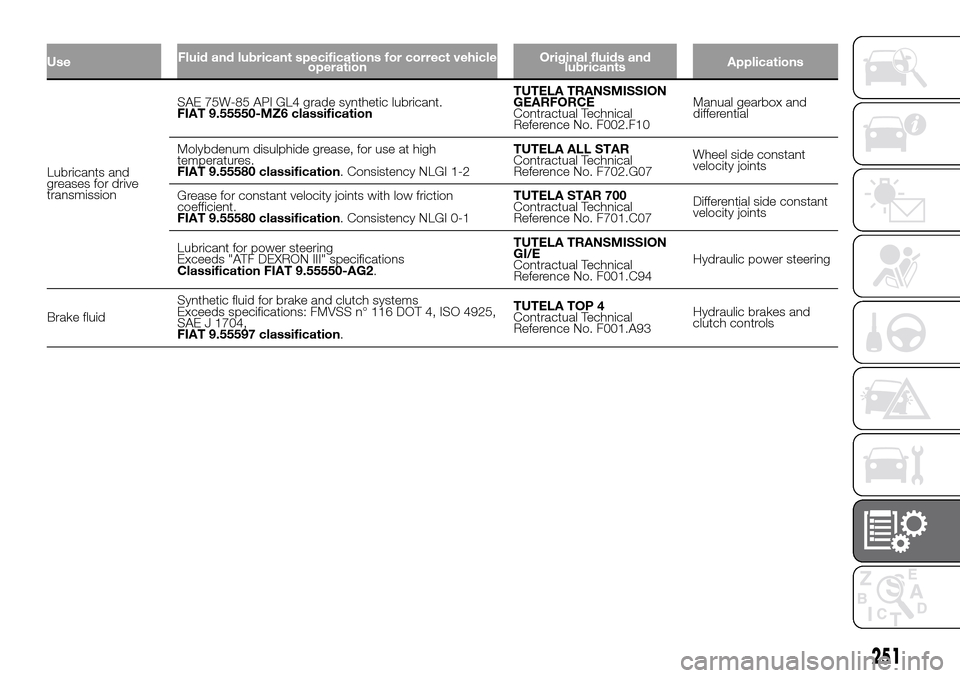
UseFluid and lubricant specifications for correct vehicle
operationOriginal fluids and
lubricantsApplications
Lubricants and
greases for drive
transmissionSAE 75W-85 API GL4 grade synthetic lubricant.
FIAT 9.55550-MZ6 classificationTUTELA TRANSMISSION
GEARFORCE
Contractual Technical
Reference No. F002.F10Manual gearbox and
differential
Molybdenum disulphide grease, for use at high
temperatures.
FIAT 9.55580 classification. Consistency NLGI 1-2TUTELA ALL STAR
Contractual Technical
Reference No. F702.G07Wheel side constant
velocity joints
Grease for constant velocity joints with low friction
coefficient.
FIAT 9.55580 classification. Consistency NLGI 0-1TUTELA STAR 700
Contractual Technical
Reference No. F701.C07Differential side constant
velocity joints
Lubricant for power steering
Exceeds "ATF DEXRON III" specifications
Classification FIAT 9.55550-AG2.TUTELA TRANSMISSION
GI/E
Contractual Technical
Reference No. F001.C94Hydraulic power steering
Brake fluidSynthetic fluid for brake and clutch systems
Exceeds specifications: FMVSS n° 116 DOT 4, ISO 4925,
SAE J 1704,
FIAT 9.55597 classification.TUTELA TOP 4
Contractual Technical
Reference No. F001.A93Hydraulic brakes and
clutch controls
251
Page 256 of 298

UseFluid and lubricant specifications for correct vehicle
operationOriginal fluids and
lubricantsApplications
Protective agent for
radiatorsRed protective with antifreeze action, based on inhibited
monoethyl glycol with organic formula. Exceeds CUNA
NC 956-16, ASTM D 3306 specifications.
FIAT 9.55523 classification.PARAFLUUP(*)
Contractual Technical
Reference No. F101.M01Cooling circuits. Use rate
50% up to -35°C. Mixture
with different formulation
products not allowed.
Diesel fuel additive Additive for diesel antifreeze, protecting diesel engines.TUTELA DIESEL ART
Contractual Technical
Reference No. F601.L06To be mixed with diesel
(25 cc per 10 litres)
Windscreen washer
fluidMixture of alcohol and surfactants CUNA NC 956-II.
FIAT 9.55522 classification.TUTELA PROFESSIONAL
SC 35
Contractual Technical
Reference No. F201.D02To be used diluted or
undiluted in windscreen
washer/wiper systems
(*)When the vehicle is used in particularly harsh weather conditions, we recommend using a mixture of 60%PARAFLUUPand 40% demineralised water.
252
TECHNICAL DATA
Page 257 of 298
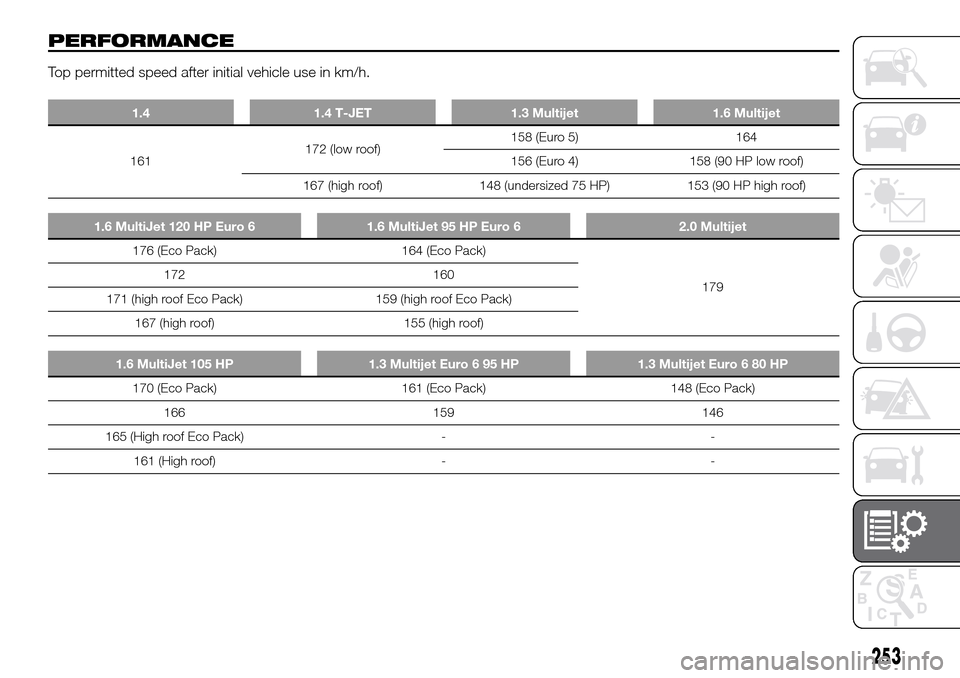
PERFORMANCE
Top permitted speed after initial vehicle use in km/h.
1.4 1.4 T-JET 1.3 Multijet 1.6 Multijet
161172 (low roof)158 (Euro 5) 164
156 (Euro 4) 158 (90 HP low roof)
167 (high roof) 148 (undersized 75 HP) 153 (90 HP high roof)
1.6 MultiJet 120 HP Euro 6 1.6 MultiJet 95 HP Euro 6 2.0 Multijet
176 (Eco Pack) 164 (Eco Pack)
179 172 160
171 (high roof Eco Pack) 159 (high roof Eco Pack)
167 (high roof) 155 (high roof)
1.6 MultiJet 105 HP 1.3 Multijet Euro 6 95 HP 1.3 Multijet Euro 6 80 HP
170 (Eco Pack) 161 (Eco Pack) 148 (Eco Pack)
166 159 146
165 (High roof Eco Pack) - -
161 (High roof) - -
253
Page 258 of 298
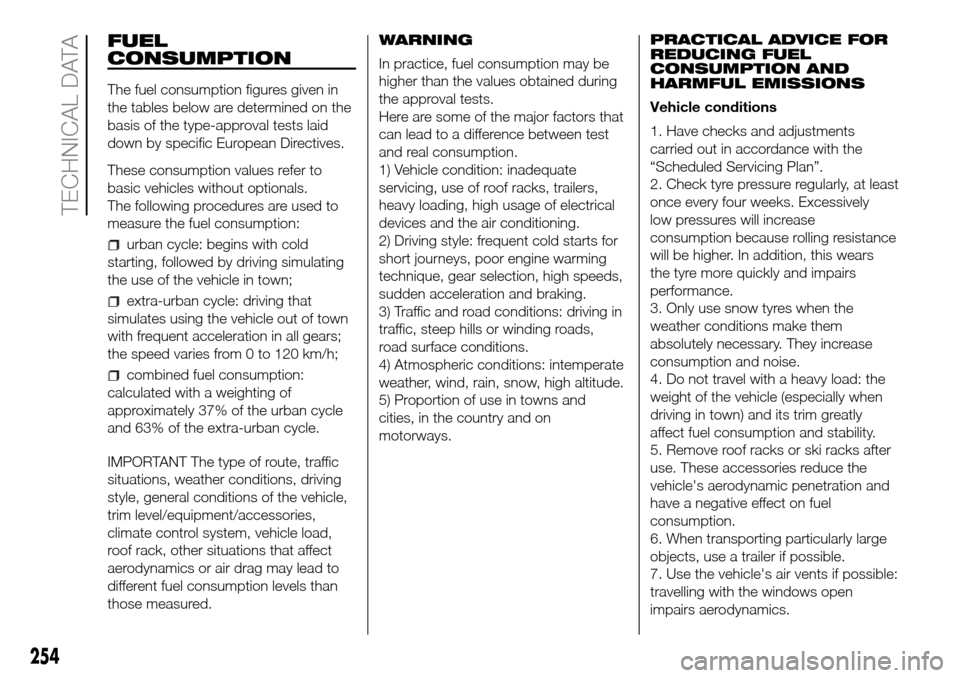
FUEL
CONSUMPTION
The fuel consumption figures given in
the tables below are determined on the
basis of the type-approval tests laid
down by specific European Directives.
These consumption values refer to
basic vehicles without optionals.
The following procedures are used to
measure the fuel consumption:
urban cycle: begins with cold
starting, followed by driving simulating
the use of the vehicle in town;
extra-urban cycle: driving that
simulates using the vehicle out of town
with frequent acceleration in all gears;
the speed varies from 0 to 120 km/h;
combined fuel consumption:
calculated with a weighting of
approximately 37% of the urban cycle
and 63% of the extra-urban cycle.
IMPORTANT The type of route, traffic
situations, weather conditions, driving
style, general conditions of the vehicle,
trim level/equipment/accessories,
climate control system, vehicle load,
roof rack, other situations that affect
aerodynamics or air drag may lead to
different fuel consumption levels than
those measured.WARNING
In practice, fuel consumption may be
higher than the values obtained during
the approval tests.
Here are some of the major factors that
can lead to a difference between test
and real consumption.
1) Vehicle condition: inadequate
servicing, use of roof racks, trailers,
heavy loading, high usage of electrical
devices and the air conditioning.
2) Driving style: frequent cold starts for
short journeys, poor engine warming
technique, gear selection, high speeds,
sudden acceleration and braking.
3) Traffic and road conditions: driving in
traffic, steep hills or winding roads,
road surface conditions.
4) Atmospheric conditions: intemperate
weather, wind, rain, snow, high altitude.
5) Proportion of use in towns and
cities, in the country and on
motorways.PRACTICAL ADVICE FOR
REDUCING FUEL
CONSUMPTION AND
HARMFUL EMISSIONS
Vehicle conditions
1. Have checks and adjustments
carried out in accordance with the
“Scheduled Servicing Plan”.
2. Check tyre pressure regularly, at least
once every four weeks. Excessively
low pressures will increase
consumption because rolling resistance
will be higher. In addition, this wears
the tyre more quickly and impairs
performance.
3. Only use snow tyres when the
weather conditions make them
absolutely necessary. They increase
consumption and noise.
4. Do not travel with a heavy load: the
weight of the vehicle (especially when
driving in town) and its trim greatly
affect fuel consumption and stability.
5. Remove roof racks or ski racks after
use. These accessories reduce the
vehicle's aerodynamic penetration and
have a negative effect on fuel
consumption.
6. When transporting particularly large
objects, use a trailer if possible.
7. Use the vehicle's air vents if possible:
travelling with the windows open
impairs aerodynamics.
254
TECHNICAL DATA
Page 259 of 298
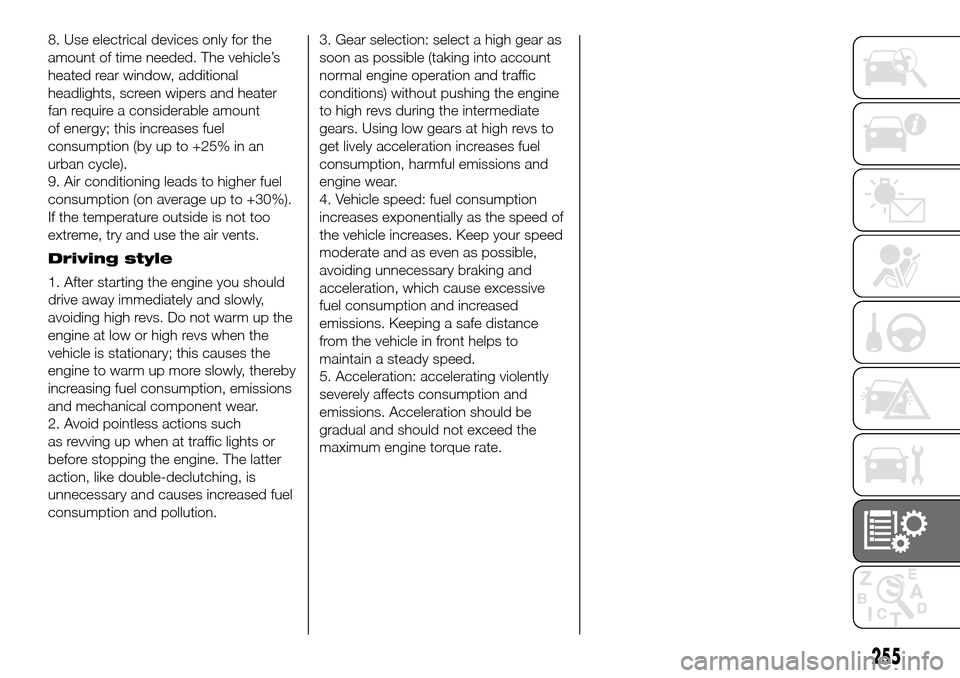
8. Use electrical devices only for the
amount of time needed. The vehicle’s
heated rear window, additional
headlights, screen wipers and heater
fan require a considerable amount
of energy; this increases fuel
consumption (by up to +25% in an
urban cycle).
9. Air conditioning leads to higher fuel
consumption (on average up to +30%).
If the temperature outside is not too
extreme, try and use the air vents.
Driving style
1. After starting the engine you should
drive away immediately and slowly,
avoiding high revs. Do not warm up the
engine at low or high revs when the
vehicle is stationary; this causes the
engine to warm up more slowly, thereby
increasing fuel consumption, emissions
and mechanical component wear.
2. Avoid pointless actions such
as revving up when at traffic lights or
before stopping the engine. The latter
action, like double-declutching, is
unnecessary and causes increased fuel
consumption and pollution.3. Gear selection: select a high gear as
soon as possible (taking into account
normal engine operation and traffic
conditions) without pushing the engine
to high revs during the intermediate
gears. Using low gears at high revs to
get lively acceleration increases fuel
consumption, harmful emissions and
engine wear.
4. Vehicle speed: fuel consumption
increases exponentially as the speed of
the vehicle increases. Keep your speed
moderate and as even as possible,
avoiding unnecessary braking and
acceleration, which cause excessive
fuel consumption and increased
emissions. Keeping a safe distance
from the vehicle in front helps to
maintain a steady speed.
5. Acceleration: accelerating violently
severely affects consumption and
emissions. Acceleration should be
gradual and should not exceed the
maximum engine torque rate.
255
Page 260 of 298
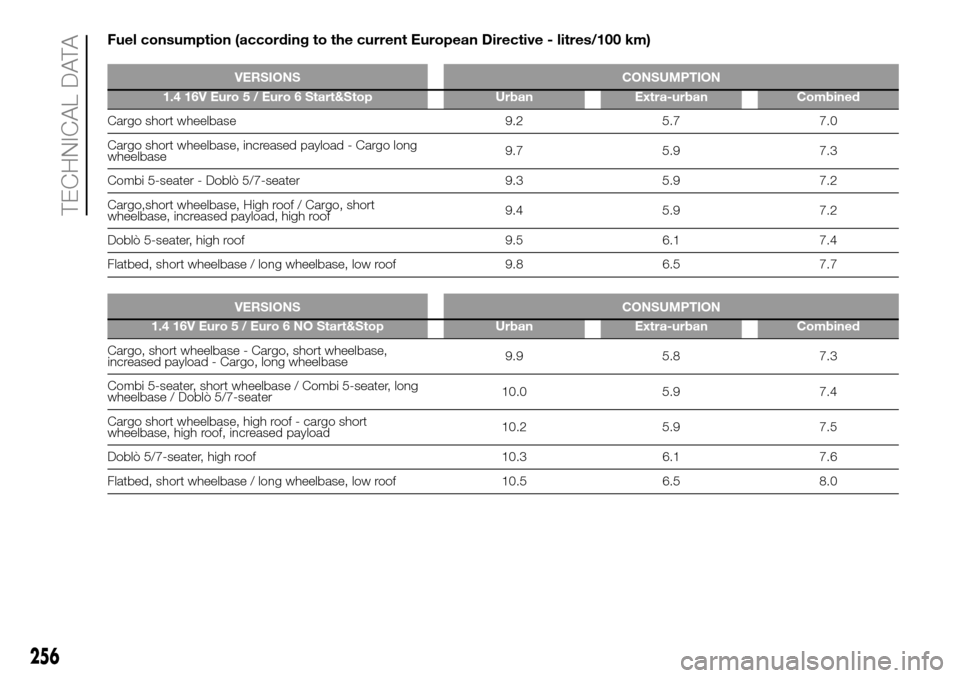
Fuel consumption (according to the current European Directive - litres/100 km)
VERSIONS CONSUMPTION
1.4 16V Euro 5 / Euro 6 Start&Stop Urban Extra-urban Combined
Cargo short wheelbase 9.2 5.7 7.0
Cargo short wheelbase, increased payload - Cargo long
wheelbase9.7 5.9 7.3
Combi 5-seater - Doblò 5/7-seater 9.3 5.9 7.2
Cargo,short wheelbase, High roof / Cargo, short
wheelbase, increased payload, high roof9.4 5.9 7.2
Doblò 5-seater, high roof 9.5 6.1 7.4
Flatbed, short wheelbase / long wheelbase, low roof 9.8 6.5 7.7
.
VERSIONS CONSUMPTION
1.4 16V Euro 5 / Euro 6 NO Start&Stop Urban Extra-urban Combined
Cargo, short wheelbase - Cargo, short wheelbase,
increased payload - Cargo, long wheelbase9.9 5.8 7.3
Combi 5-seater, short wheelbase / Combi 5-seater, long
wheelbase / Doblò 5/7-seater10.0 5.9 7.4
Cargo short wheelbase, high roof - cargo short
wheelbase, high roof, increased payload10.2 5.9 7.5
Doblò 5/7-seater, high roof 10.3 6.1 7.6
Flatbed, short wheelbase / long wheelbase, low roof 10.5 6.5 8.0
256
TECHNICAL DATA